All entries for April 2013
April 29, 2013
First cabbage root flies caught
We caught our first cabbage root flies at Wellesbourne today (total of 5 males from 3 water traps). The males start to emerge slightly earlier than the females. Still no carrot flies on our stcky traps.
There are one or two flea beetle feeding holes in our newly-emerged swede seedlings.
April 26, 2013
And still no cabbage root flies or carrot flies….......
The Wellesbourne traps were checked again yesterday and there were still no cabbage root flies or carrot flies (supporting what the forecasts indicate). There were quite a few bean seed flies, pollen beetles and one flea beetle in the water traps.
April 25, 2013
Update from Rothamsted Research on suction trap captures
Our forecasts issued at the beginning of March predicted a later than average time for first flights this year, especially in the south, based on January and February temperatures. March was the joint second coldest in the UK since records began more than 100 years ago, and this cold period continued into the first half of April. All this has resulted in very few aphids in our suction traps so far this year.
Next week we will start issuing the weekly data bulletins with associated news sheets.
Silver Y moths late
The light traps run by moth entusiasts capture two species of migrant moth that can be pests of vegetable crops - silver Y moth and diamond-back moth. There is a particularly active group of 'moth catchers' in Dorset and their website details captures.
Last year the first silver Y moths were caught on 28th March. They have yet to be captured this year. Another sign of the late season!.
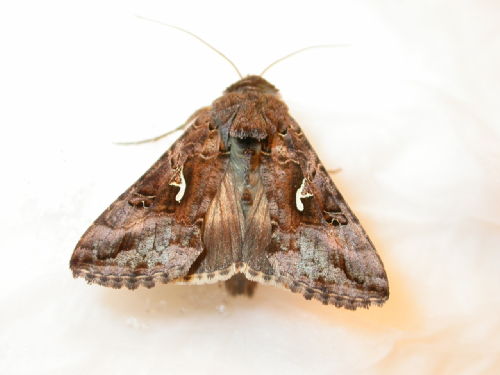
April 23, 2013
Still no cabbage root flies or carrot flies in our traps at Wellesbourne
The traps were checked again today - and still no cabbage root flies or carrot flies. The numbers of bean seed flies had increased though.
April 19, 2013
Not much in our traps today!
Still no cabbage root flies or carrot flies in our traps today - tying in well with the forecasts. All we caught were a few bean seed flies and a few flea beetles in our water traps.
April 18, 2013
Pest bulletin currently unavailable
There are some problems with the Syngenta web pages and we apologise for the fact that the pest bulletin is currently unavailable. We hope it will be restored by Monday at the latest.
Pest sitings
Active pollen beetles (in picture) were seen in south-east England on 14 April, the same day they were seen in Gloucestershire (see previous blog). Infestations of thrips have been observed on overwintered onions - also in south-east England.
When we checked our traps at Wellesbourne at the beginning of the week there were a few bean seed flies. We have not captured any carrot flies or cabbage root flies yet.
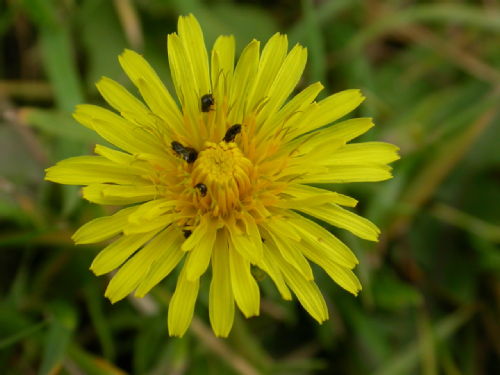
Updated day–degree graph
Now that it's a bit warmer we're starting to accumulate a few more day-degrees at Wellesbourne. The first graph shows accumulated day-degrees above 0°C. The second graph uses a higher threshold of 4.4°C, which is close to the low temperature threshold for development of many pest species. This emphasises how slowly most pests will have been developing over the last two months or so. Howevcer, the last few days have been much 'better' for pest development!
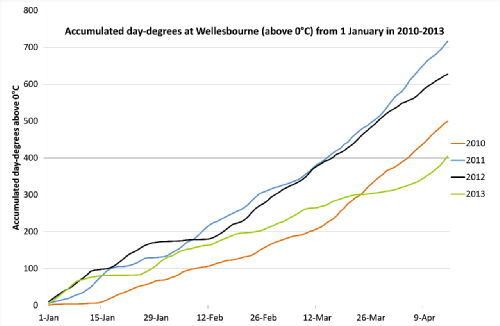
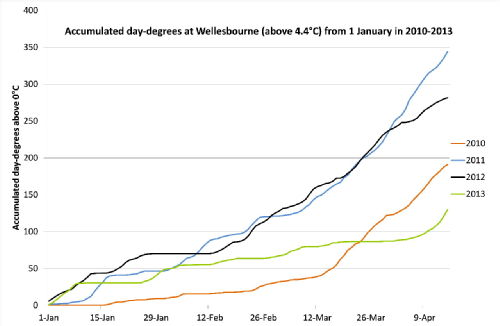
April 14, 2013
Pollen beetles are starting to emerge from 'hibernation'
Pollen beetles overwinter as adults and emerge when it begins to warm up in the spring. They feed on various flowers (often yellow ones such as dandelions) and later move on to feed on the flower buds of cruciferous plants (e.g. oil seed rape and weeds such as charlock) where they feed and lay eggs. It is the adults produced subsequently that sometimes damage horticultural brassicas. Today was the warmest day so far of spring 2013 and I spotted pollen beetles on several flowers including the coltsfoot shown below.
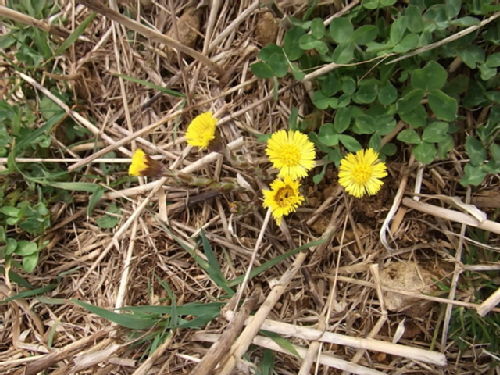
 Rosemary Collier
Rosemary Collier

 Please wait - comments are loading
Please wait - comments are loading
 Loading…
Loading…
